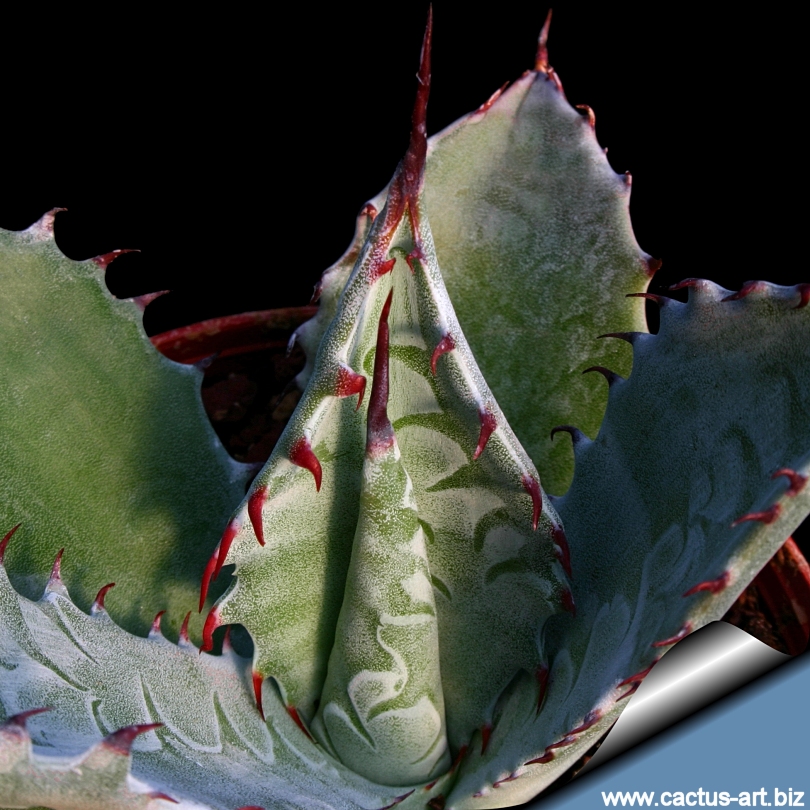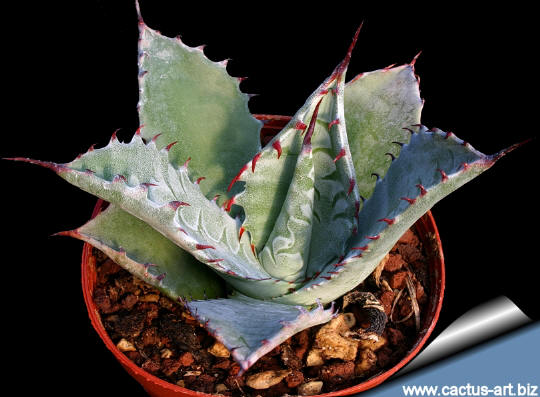|
|
|

Agave
parry RUBY ( A juvenile plant)
This is one of the most striking and ornamental agaves, old
plants are highly
prized and make great landscaping items, as well as excellent potted
plants.
The leaves in full sun take a nice purple tinge (hence the name).
|
|
Description: Agave parryi
is a perennial succulent that forms a beautiful compact rosette, slowly
growing up to 90cm in diameter, 60 cm tall depending on subspecies. It
(usually) offsets freely forming a small shrub, assuring more plants to
replace the original plant once it has flowered, but tends to be slow to
sucker.
Leaves: Broad short blue-gray with a long dark prominent spine at
the tip and dark brown teeth on the margins.
Flowers: The flower stalk is up to 4,5m tall it starts out like a
giant stalks of asparagus, is then topped by a glorious bouquet. The
small flowers begin as red or pink buds, opening to a bright yellow they
will attract hummingbirds from kilometers around.
Blooming season: Blooms in late spring, early summer only when the plant
is 20 years old or more. The plant then dies leaving suckers that grow
into replacement plants.
Use: It is attractive massed in the succulent garden as a large
scale groundcover they are also wonderful when used for accent or simply
to provide some all year round foliage colour and often used in a pot as
a patio plant, they make an eye-catching statement and along with other
evergreen plants in pots, can be moved around to change the scenery or
position to give more shelter. It is also well suited for containers.
The Indians also used the century plant as a source of food, fibres,
soap, medicine and weapons.
Photo of conspecific taxa, varieties, forms and
cultivars of Agave parryi:
|
|
Advertising
|
|
|
|
|
Family: Agavaceae
Scientific Name: Agave parryi Engelm.
cv RUBY
Common Names include: Parry's Agave, Century plant
Origin:
Garden origin (Nursery
selected cultivar)
Ecology: Like most Agave species, this plant
is monocarpic, meaning that it will only bloom and bear fruit once
during its life before dying. As Agaves approach maturity at 10 to 30
years of age, they accumulate a large amount of carbohydrates in their
tissues that provide the energy that fuels the rapid development of the
large flower spike.
Heterotypic synonyms:
- Agave patonii,
- Agave chihuahuana,
- Agave scabra,
- Agave wislizeni,
- Agave chihuahuana,
- Agave americana var. latifolia
|
|
|
|

It look like a giant artichoke with somewhat
wide, short pale blue leaves and a dark-red, sharp terminal spine and
small, but very sharp reddish lateral leaf spines.
Cultivation: A very slow
growing agave, parryi is a real beauty and worth the wait, it is highly
ornamental and very beautiful. Like all agaves, A. parryi is extremely
drought tolerant. Although it will grow larger with supplemental water,
its roots need to be in well-drained soil, and will rot if kept wet.
Several varieties are offered in the trade. Likes full sun, but will
tolerate shade. One of the hardiest agaves (Resistant to -7°C or less)
In winter watering this plant can be done once every 1-2 months, there
is no need to mist the leaves.
Propagation: Relatively
easy to propagate by seeds. (Barely cover the
seeds using well draining soil mix. Keep lightly moist. Provide filtered
sunlight until germinated and gradually move to brighter light)
or by
suckers (Remove the basal suckers in spring or summer and let
the cuttings dry for a few days before inserting in compost)

 |
|